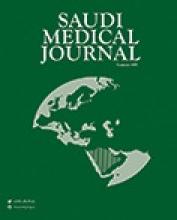Abstract
OBJECTIVE: To evaluate blood and serum markers in traumatic spinal cord injured (SCI) patients, with and without pressure sores.
METHODS: This cross-sectional study was performed at the Ministry of Health Diskapi Yildirim Beyazit, and Numune Education and Research Hospitals, Ankara, Turkey, from 2006-2008. A total of 23 SCI patients with pressure sores (group I) and a control group of 25 SCI patients without pressure sores (group II) were evaluated. Characteristics of sores were examined with respect to duration, location, grade, tissue types, surface area, and exudate amount. Recorded laboratory parameters included erythrocyte sedimentation rates (ESR), C-reactive protein (CRP), hemoglobin (Hb), hematocrit (Htc), lymphocytes, white blood cells (WBC), red blood cells (RBC), serum iron, transferrin, total iron-binding capacity (TIBC), ferritin, total protein, albumin, vitamin B12, and zinc.
RESULTS: The most common pressure sore location was the sacrum (38%). Compared to the control group, the patients with pressure sores showed anemia with reduced serum iron, transferrin, TIBC, and increased ferritin. They also had increased ESR, CRP, and WBC and reduced lymphocytes, total protein, albumin and zinc. Statistically significant correlations were found between CRP, Hb, Htc, lymphocytes, RBC, WBC, and serum protein levels, and grade of pressure sores.
CONCLUSION: Clinicians should regularly screen patients with respect to blood and serum markers, in order to determine any risks for pressure sores, and they should perform immediate preventive measures based on the patient's condition.
- Copyright: © Saudi Medical Journal
This is an open-access article distributed under the terms of the Creative Commons Attribution-Noncommercial-Share Alike 3.0 Unported, which permits unrestricted use, distribution, and reproduction in any medium, provided the original work is properly cited.






